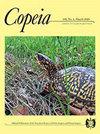Functional Responses of Larval Marbled Salamanders (Ambystoma opacum) and Adult Lesser Sirens (Siren intermedia) on Anuran Tadpole Prey
IF 2.6
Q2 Agricultural and Biological Sciences
引用次数: 2
Abstract
Predation can have strong effects on the structure of pond-breeding amphibian communities. Many factors can influence the outcome of predator–prey interactions, including differences in densities, identities, and body sizes of both predator and prey. These different mediating factors can impart synergistic impacts on predation rates, though distinguishing such interactions among multiple factors are underexplored. We examined whether different body sizes of two predators, larval Marbled Salamanders (Ambystoma opacum) and adult Lesser Sirens (Siren intermedia), varied in their ability to forage on larval anurans across a range of prey densities. We specifically tested whether attack rates and handling times, the two main parameters of functional response models, varied across three size classes in both predator species. We found that larval Marbled Salamanders exhibited a Type II (saturating) functional response and that larger individuals had higher attack rates and shorter handling times, resulting in greater prey mortality at higher prey densities with larger predators. In contrast, Lesser Sirens were largely ineffective predators despite being an order of magnitude larger in body size than Marbled Salamanders; tadpole mortality was largely unrelated to their own density. Predator body size was a significant predictor of prey mortality for both predator species. Overall, our study shows that species identity could be as important as predator body size when predicting the outcomes of predator–prey interactions.幼年大理石纹蝾螈(Ambystoma opacum)和成年小Siren(中间Siren intermedia)对Anuran蝌蚪捕食的功能反应
捕食会对池塘养殖两栖动物群落的结构产生强烈影响。许多因素会影响捕食者与猎物相互作用的结果,包括捕食者和猎物的密度、身份和体型的差异。这些不同的中介因素可以对捕食率产生协同影响,尽管在多种因素之间区分这种相互作用尚不充分。我们研究了两种捕食者的不同体型,即幼年Marbled Salamanders(Ambystoma opacum)和成年Lesser Sirens(Siren intermedia),在不同的猎物密度下,它们在无尾幼体身上觅食的能力是否不同。我们特别测试了攻击率和处理时间这两个功能反应模型的主要参数是否在两个捕食者物种的三个体型类别中存在差异。我们发现,大理石纹蝾螈幼虫表现出II型(饱和)功能反应,体型较大的个体攻击率更高,处理时间更短,导致捕食者体型较大,猎物密度越高,猎物死亡率越高。相比之下,小Sirens在很大程度上是无效的捕食者,尽管它的体型比Marbled Salamanders大一个数量级;蝌蚪的死亡率在很大程度上与它们自身的密度无关。捕食者的体型是两种捕食者猎物死亡率的重要预测因子。总的来说,我们的研究表明,在预测捕食者与猎物相互作用的结果时,物种身份可能与捕食者的体型一样重要。
本文章由计算机程序翻译,如有差异,请以英文原文为准。
求助全文
约1分钟内获得全文
求助全文
来源期刊

Copeia
生物-动物学
CiteScore
2.10
自引率
0.00%
发文量
0
审稿时长
6-12 weeks
期刊介绍:
Founded in 1913, Copeia is a highly respected international journal dedicated to the publication of high quality, original research papers on the behavior, conservation, ecology, genetics, morphology, evolution, physiology, systematics and taxonomy of extant and extinct fishes, amphibians, and reptiles. Copeia is published electronically and is available through BioOne. Articles are published online first, and print issues appear four times per year. In addition to research articles, Copeia publishes invited review papers, book reviews, and compiles virtual issues on topics of interest drawn from papers previously published in the journal.
 求助内容:
求助内容: 应助结果提醒方式:
应助结果提醒方式:


